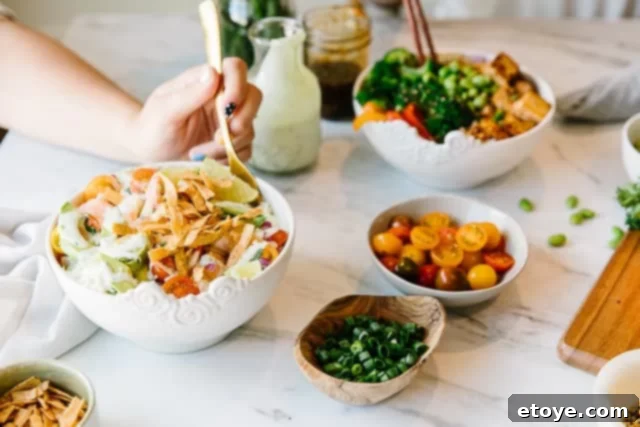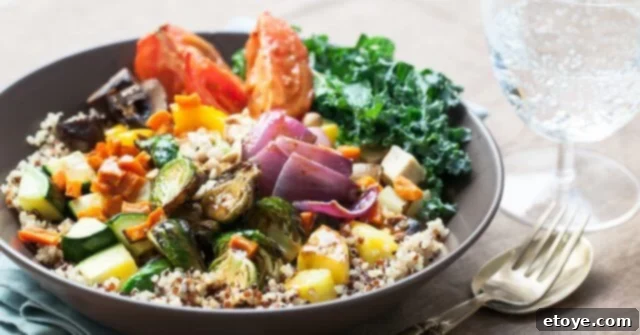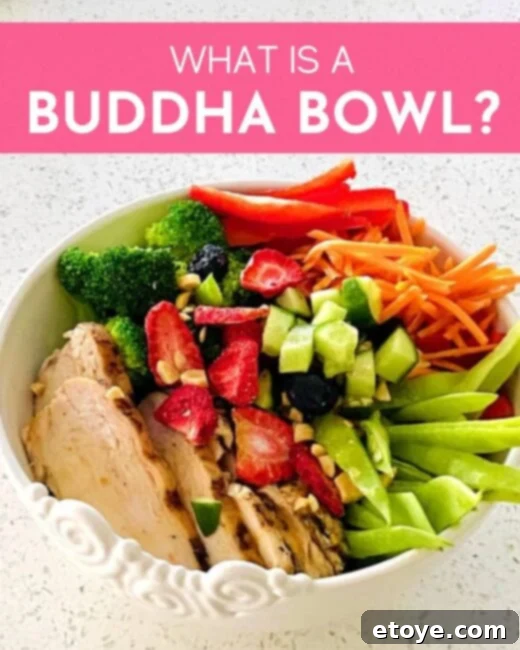Unveiling the Buddha Bowl: Your Guide to Wholesome and Delicious One-Bowl Meals
In the bustling world of modern nutrition, the Buddha Bowl has emerged as a beacon of healthy, convenient, and incredibly satisfying eating. More than just a meal, it’s a culinary philosophy centered around creating a beautifully balanced, nutrient-dense plate in a single bowl. Imagine a vibrant canvas of colors and textures, each element thoughtfully chosen to contribute to your well-being. These versatile one-bowl meals offer an effortless solution for repurposing ingredients, minimizing food waste, and enjoying a delicious, wholesome experience.
At its core, a Buddha Bowl embodies the principles of mindful eating, combining a diverse array of whole foods – from hearty grains and fresh vegetables to lean proteins and flavorful dressings. They are renowned for their ability to transform seemingly disparate ingredients into a harmonious and incredibly nutritious dish. Whether you’re a seasoned chef or a beginner in the kitchen, the simple, adaptable formula of a Buddha Bowl makes healthy eating accessible, saving you both time and money.
Join us as we explore the rich history, diverse interpretations, and practical steps to crafting your own perfectly balanced and delectable Buddha Bowls. Discover how these bowls can revolutionize your approach to healthy eating, making every meal an exciting journey of flavor and nourishment.

The Humble Origins: Tracing the History of the Buddha Bowl
The name “Buddha Bowl” itself often sparks curiosity, conjuring images of abundance and serene contentment. Interestingly, while modern interpretations emphasize a generously filled bowl, the true inspiration stems from a much more minimalist and mindful practice. Contrary to the popular, often rotund depictions, the historical Buddha was known for his lean physique, a result of a disciplined lifestyle and a unique approach to sustenance.
For thousands of years, Buddhist monks have observed specific eating customs, focusing more on when they eat rather than what specific foods comprise their meals. The Buddha himself adhered to eating only at designated times during the day, a practice that bears a striking resemblance to what is now recognized as intermittent fasting. This disciplined approach wasn’t about deprivation, but about fostering mindfulness and a deeper connection to the act of eating.
A central tenet of this tradition involved the Buddha walking through villages, carrying a simple begging bowl. Local villagers, out of generosity and spiritual devotion, would fill his bowl with whatever food they could spare. This could be anything from grains and vegetables to small portions of protein, all mixed together. The Buddha accepted these offerings without judgment, consuming whatever was presented. This practice highlights the core philosophy of acceptance, simplicity, and gratitude for nourishment.
From this ancient tradition, the concept of a “one-bowl meal” naturally emerged – a simple yet complete compilation of various ingredients, often colorful and diverse, brought together in a single vessel. While the contemporary Buddha Bowl has evolved to include curated, aesthetically pleasing components, its spirit remains rooted in these humble beginnings: a holistic, balanced meal that nourishes both body and soul, often embracing whatever wholesome ingredients are readily available.

Navigating the Bowl Trend: How Buddha Bowls Stand Apart
The culinary landscape is brimming with various ‘bowl’ concepts, each offering a unique approach to healthy eating. While many share similar components, their underlying philosophy and emphasis often differ. Understanding these distinctions can help you appreciate the specific charm and versatility of the Buddha Bowl. Let’s break down some popular bowl types and see how they compare to the modern Buddha Bowl.
Nourish Bowls: Fueling Your Body with Essential Nutrients
As their name suggests, Nourish Bowls are meticulously crafted with nutrient density as their primary goal. These bowls are powerhouses of essential vitamins, minerals, and macronutrients, designed to deeply fuel your body. Typically, a Nourish Bowl features a generous combination of fresh, vibrant vegetables, robust whole grains, lean protein sources, and beneficial healthy fats. The emphasis here is on providing sustained energy and supporting overall health, ensuring every spoonful contributes to your well-being. They aim to not just fill you up, but to truly nourish every cell.
Power Bowls: Boosting Energy for Active Lifestyles
Designed for individuals leading active lives or those needing an extra energy boost, Power Bowls often prioritize high-protein ingredients. These can include anything from grilled chicken and fish to lentils and quinoa, all aimed at supporting muscle growth and expediting post-workout recovery. While many commercial Acai Bowl shops market their offerings as Power Bowls, it’s crucial to distinguish. Often, these can be surprisingly indulgent and calorie-dense, packed with high-sugar fruits, granola, and toppings like chocolate chips, which might not align with a genuinely health-conscious “power” meal. A true Power Bowl, prepared mindfully, focuses on lean protein and complex carbohydrates for sustained energy.
Hippie Bowls: Embracing Plant-Based and Sustainable Eating
Hippie Bowls champion a plant-based, holistic lifestyle. Their core philosophy revolves around whole, unprocessed ingredients and shunning animal proteins. These colorful bowls are typically brimming with a wide array of vegetables, complemented by plant-based protein sources such as legumes, nuts, and seeds. Beyond personal health, Hippie Bowls often reflect an ethos of environmental sustainability and a desire for a more natural, earth-conscious diet. They celebrate the abundance of the plant kingdom and encourage a harmonious relationship with food and nature.
Grain Bowls: The Foundation of Wholesome Goodness
Often considered a close cousin, or even a synonym, for Buddha Bowls, Grain Bowls place a specific emphasis on whole grains as their primary base. Think quinoa, brown rice, farro, barley, or millet – these grains provide complex carbohydrates, fiber, and a satisfying texture. Like Buddha Bowls, Grain Bowls are typically augmented with a medley of fresh vegetables, a protein source (which can be plant-based or animal-based), and a delicious dressing to tie all the flavors together. Their versatility makes them incredibly adaptable to various dietary preferences and culinary creations.
Macro Bowls: Adhering to Macrobiotic Principles
Short for macrobiotic, Macro Bowls are rooted in the principles of the macrobiotic diet, a dietary approach focused on balancing whole grains, vegetables, beans, and fermented foods. This philosophy extends beyond mere nutrition, aiming to promote overall health, harmony, and longevity through food choices. Macrobiotic eating also emphasizes consuming seasonal and locally sourced ingredients, actively avoiding processed foods, and striving for a balanced intake of yin and yang foods. These bowls are therefore very deliberate in their composition, adhering to specific dietary guidelines.
The Distinctive Charm of the Buddha Bowl: A Harmonious Blend
While the lines between these bowl types can sometimes blur due to overlapping ingredients, the primary differentiator lies in their intent and comprehensive nature. This is precisely where the beauty of the Buddha Bowl shines. It’s not just a trend; it’s a wonderfully inclusive concept that skillfully integrates the best elements from Nourish Bowls, Grain Bowls, and Hippie Bowls into a single, cohesive meal.
A true Buddha Bowl is characterized by its vibrant aesthetic and balanced composition: a foundation of grains or greens, a rich assortment of both raw and cooked vegetables, a lean protein (which can be plant-based, pescatarian, or animal-based for omnivores), and is always crowned with a flavorful dressing and often a delightful crunchy topping for added texture. They are celebrated for their incredible versatility, allowing for endless customization to suit any dietary preference, whether you’re crafting a vegan Buddha Bowl, a vegetarian option, or one with lean meats. The Buddha Bowl truly offers a holistic and satisfying dining experience, making healthy eating both enjoyable and effortlessly achievable.

Crafting Your Masterpiece: A Step-by-Step Guide to Building Your Perfect Buddha Bowl
One of the most appealing aspects of the Buddha Bowl is its inherent flexibility and the sheer joy of creation. Building your own customizable Buddha Bowl is not just simple; it’s an opportunity for culinary expression, allowing you to tailor every element to your taste, dietary needs, and whatever ingredients you have on hand. Follow this easy formula to construct a perfectly balanced, visually stunning, and deeply satisfying meal every time.
1. Lay the Foundation: Choose Your Base
Every great Buddha Bowl starts with a solid foundation. This is typically a bed of wholesome grains or fresh leafy greens. For grains, consider nutrient-rich options like fluffy quinoa, brown rice, wild rice, farro, couscous, or even whole wheat pasta or rice noodles. If you prefer a lighter, lower-carb base, vibrant greens such as spinach, kale, mixed salad greens, or romaine lettuce work beautifully. You can even combine a small portion of grains with a generous serving of greens for the best of both worlds. The base provides essential fiber and energy, setting the stage for the flavors to come.
2. Infuse Color and Nutrients: Add a Medley of Vegetables
This is where your Buddha Bowl truly comes alive! Aim for a diverse array of colorful vegetables, incorporating both raw and cooked options for varied textures and nutritional profiles. Think beyond the usual suspects: roasted sweet potatoes or Brussels sprouts, steamed broccoli or asparagus, crisp bell peppers, cherry tomatoes, shredded carrots, purple cabbage, refreshing cucumber, or even pickled onions. Utilize seasonal produce for maximum flavor and nutritional value. Don’t be afraid to experiment with different preparation methods – grilling, steaming, roasting, or simply enjoying them fresh – to discover your favorites.
3. Power Up: Integrate a Lean Protein
A quality protein source is crucial for satiety and muscle health, making your Buddha Bowl a complete and satisfying meal. The beauty here is the choice: plant-based options like black beans, chickpeas, lentils, edamame, tofu (baked or pan-fried), or tempeh are fantastic for a vegan or vegetarian Buddha Bowl. For those who enjoy animal proteins, grilled chicken breast, baked salmon, pan-seared shrimp, shredded turkey, or even a hard-boiled egg can elevate your bowl. Ensure your protein is cooked simply and seasoned well to complement the other ingredients.
4. The Unifying Element: Drizzle with a Flavorful Sauce
The sauce is the soul of your Buddha Bowl, bringing all the disparate ingredients together into a cohesive flavor experience. While store-bought dressings offer convenience, crafting your own allows for complete control over ingredients and freshness. Simple vinaigrettes (olive oil, vinegar, Dijon mustard), creamy tahini-lemon dressings, spicy peanut sauce, homemade pesto, or even a basic mix of soy sauce and sesame oil are easy and delicious. Don’t underestimate the power of a well-chosen dressing to elevate your bowl from good to truly exceptional. This component adds moisture, binds flavors, and provides healthy fats.
5. The Grand Finale: Elevate with Crunchy Toppings and Garnishes
Texture is just as important as flavor in a satisfying meal. Finish your Buddha Bowl with a handful of crunchy toppings to add an exciting textural contrast. Options include toasted seeds (sunflower, pumpkin, sesame, chia), chopped nuts (almonds, walnuts, pecans), crispy chickpeas, roasted seaweed, or even homemade croutons. Beyond crunch, consider fresh herbs like cilantro or parsley, a sprinkle of nutritional yeast for a cheesy flavor, or a dash of chili flakes for a kick. These garnishes add not only texture but also an extra layer of flavor and visual appeal, completing your culinary masterpiece.
Are Buddha Bowls Truly Healthy? Unpacking Their Nutritional Benefits
The perception of a Buddha Bowl as a “healthy meal” is largely accurate, yet its ultimate nutritional value hinges entirely on the choices you make during its construction. By definition, Buddha Bowls are designed to be wholesome and balanced, but just like any customizable dish, it’s possible to inadvertently load them with less-than-ideal ingredients.
To ensure your Buddha Bowl maximizes its health potential, focus on incorporating truly nutrient-dense foods. This includes a generous foundation of fresh, seasonal vegetables (both raw and cooked), a serving of complex whole grains, and a lean, high-quality protein source. This combination aligns with dietary principles often found in East Asian culinary traditions, which are celebrated for their anti-inflammatory properties and ability to support overall well-being. Such a composition provides a rich array of fiber, vitamins, minerals, and antioxidants, contributing to sustained energy and improved digestive health.
However, an often-overlooked component is the dressing. While a delicious sauce can elevate your bowl, it can also quickly become a source of hidden sugars, unhealthy fats, and artificial preservatives if not chosen carefully. Opt for homemade dressings whenever possible, using healthy fats like olive oil or tahini, natural acids like lemon juice or apple cider vinegar, and minimal added sugar. Be mindful of portion sizes, especially with higher-calorie ingredients like nuts, seeds, and certain dressings, to keep your bowl balanced and aligned with your dietary goals.
When thoughtfully assembled, a Buddha Bowl is an excellent tool for mindful eating, portion control, and ensuring a diverse intake of whole foods. It’s an ideal choice for anyone seeking a delicious, convenient, and highly nutritious meal that supports a balanced and healthy lifestyle.

Elevate Your Experience: Expert Tips for Crafting the Ultimate Buddha Bowl
While the basic formula for a Buddha Bowl is straightforward, a few key strategies can transform a good bowl into an extraordinary one. These tips focus on enhancing flavor, maximizing nutritional value, and making the most of your kitchen resources, ensuring every Buddha Bowl you create is a culinary delight.
Harmonize Flavors and Textures for a Dynamic Experience
A truly exceptional Buddha Bowl is a symphony of sensations. Strive for a thoughtful balance of the five basic tastes – sweet, salty, savory (umami), sour (tangy), and spicy – to create a complex and satisfying flavor profile. Beyond taste, textural contrast is paramount. Combine crunchy elements like toasted nuts or fresh cucumbers, with creamy components such as avocado or a rich tahini dressing, and chewy textures from grains or roasted vegetables. For instance, roasted sweet potatoes add natural sweetness and a soft texture, while quick-pickled red onions provide a vibrant tang and a satisfying crunch. A mix of fresh herbs can add a peppery or refreshing zing. Thinking about these contrasts will make each bite interesting and prevent your bowl from feeling monotonous.
Unleash Creativity with Dressings and Seasonings
The dressing is arguably the most transformative element in a Buddha Bowl. Many core ingredients – from grains and leafy greens to tofu and lean proteins – are excellent flavor carriers, allowing your dressing to define the entire character of your meal. Don’t be afraid to venture beyond a basic vinaigrette. Explore rich options like a ginger-sesame dressing, a creamy cashew-based sauce, a spicy chipotle-lime crema, or a vibrant cilantro-lime dressing. Experiment with adding fresh herbs, garlic, ginger, or a touch of miso for umami depth. Additionally, don’t forget pre-seasoning your protein and roasted vegetables. A well-seasoned chicken breast or perfectly spiced chickpeas will contribute significantly to the overall flavor complexity, making your bowl an unforgettable experience.
Embrace the Seasons: Incorporate Seasonal Produce
Cooking with seasonal produce is a simple yet powerful way to enhance your Buddha Bowls. Vegetables and fruits that are in season are not only at their peak in terms of flavor and nutritional content, but they are often more affordable and support local agriculture. This practice encourages variety in your diet throughout the year and ensures you’re consuming the freshest possible ingredients. Visit your local farmer’s market to discover what’s currently thriving and let that inspire your next bowl creation, connecting you more deeply with the rhythm of nature and your local community.
Master the Art of Meal Prep and Leftover Reinvention
Buddha Bowls are the ultimate champions of meal prep and ingenious leftover repurposing. Cook a larger batch of grains, roast extra vegetables, or prepare a double portion of protein at the beginning of the week. These components can then be mixed and matched throughout the week, significantly cutting down on daily cooking time. Even small quantities of “about-to-turn” vegetables or leftover rice can find a new, delicious life in a Buddha Bowl, effectively reducing food waste and saving you money. This approach makes healthy eating effortless and sustainable, turning your fridge into a personalized, ready-to-assemble Buddha Bowl bar.
Mindful Presentation: Eat with Your Eyes First
While often overlooked, the visual appeal of your Buddha Bowl can significantly enhance your dining experience. Arrange your ingredients artfully in the bowl, creating distinct sections of color and texture. A visually appealing meal not only sparks appetite but also encourages more mindful eating. A sprinkle of fresh herbs, a drizzle of contrasting sauce, or a few strategically placed seeds can transform a simple meal into a feast for the eyes, making it even more enjoyable and satisfying.
A Global Plate: Exploring International Buddha Bowl Variations
The inherent versatility of the Buddha Bowl makes it an ideal canvas for exploring global flavors. By simply swapping out a few key ingredients and dressings, you can transport your taste buds to different corners of the world, creating exciting and culturally inspired meals. Here’s how you can infuse your Buddha Bowls with international flair, showcasing their adaptability as customizable healthy meals.
Mexican-Inspired Buddha Bowl: A Fiesta in a Bowl
Bring the vibrant flavors of Mexico to your bowl. Start with a hearty base of brown rice, cilantro-lime rice, or even seasoned quinoa. Pile on classic Mexican components: protein-rich black beans or pinto beans, grilled corn, diced bell peppers, and fresh pico de gallo. For protein, consider seasoned ground turkey, grilled chicken, or plant-based options like seasoned tofu or jackfruit. Top generously with creamy avocado slices or guacamole, a squeeze of fresh lime juice, a sprinkle of chili powder or smoked paprika, and perhaps a dollop of Greek yogurt or a creamy chipotle dressing. For an adventurous twist, serve your vibrant creation within a crispy taco shell bowl for an extra layer of texture and fun.
Mediterranean Buddha Bowl: Sunshine and Savory Herbs
Embrace the fresh, bright, and healthy ingredients characteristic of the Mediterranean diet. Your base could be fluffy quinoa, pearl couscous, or a bed of mixed greens. Add crisp cucumbers, juicy cherry tomatoes, thinly sliced red onions, and briny Kalamata olives. Creamy feta cheese is a must for an authentic touch (or a plant-based alternative). For protein, grilled chicken, baked salmon, or chickpeas are excellent choices. Finish with a generous drizzle of extra virgin olive oil, a squeeze of fresh lemon juice, and a sprinkle of dried oregano or fresh parsley. A swirl of hummus or a tzatziki-inspired dressing can add a wonderful creamy element.
Asian-Inspired Buddha Bowl: Umami-Rich and Flavorful
Dive into the diverse and aromatic flavors of Asia. Select a base of white rice, brown rice, or delicate rice noodles. Populate your bowl with an assortment of raw and lightly cooked vegetables such as shredded carrots, vibrant purple cabbage, crisp snow peas, tender edamame, and sliced radishes. Lean protein options include pan-seared shrimp, baked tofu, shredded chicken, or thinly sliced beef. The dressing is key here: a mix of soy sauce (or tamari), sesame oil, rice vinegar, a touch of honey or maple syrup, and fresh ginger and garlic. Garnish with toasted sesame seeds, chopped green onions, and fresh cilantro for an authentic finish.
Indian-Inspired Buddha Bowl: Aromatic Spices and Rich Textures
For a warm and comforting bowl, explore the rich tapestry of Indian flavors. A base of basmati rice or brown rice works beautifully. Layer with spiced components like curried chickpeas, roasted cauliflower and potatoes, or sautéed spinach. For protein, consider a fragrant lentil dal, paneer cheese, or tandoori-spiced chicken. Add fresh elements like cucumber-tomato raita, pickled red onions, or a sprinkle of fresh cilantro. A creamy yogurt-based dressing infused with mint and cumin, or a simple tamarind drizzle, will bring all the aromatic spices together for a truly unique and delicious Buddha Bowl experience.

Your Culinary Adventure Awaits: Crafting Your Signature Buddha Bowl
The journey into the world of Buddha Bowls is one of discovery, creativity, and profound satisfaction. Far from being a rigid recipe, the Buddha Bowl is an open invitation to play with flavors, textures, and ingredients, transforming simple components into a wholesome and delightful meal. It’s an empowering way to take control of your nutrition, reduce waste, and truly enjoy the process of preparing and consuming food.
We’ve explored its mindful origins, its distinction from other popular bowl trends, the simple steps to assemble your own, and endless possibilities for global inspiration. Now, the canvas is yours. Embrace the freedom to experiment with new vegetables, adventurous proteins, and vibrant dressings. Let your pantry and refrigerator guide your choices, creating unique combinations that cater precisely to your cravings and nutritional goals.
So, tell us: what delicious ingredients will find their way into your next healthy Buddha Bowl? Share your favorite combinations and inventive ideas in the comments below! We’re eager to hear how you’re making these versatile, nutritious, and incredibly flavorful one-bowl meals your own.
